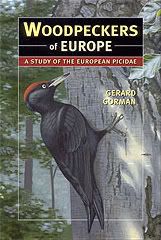Wednesday, 27 October 2010
Green Woodpecker foraging on thatched roof
I received this note and photo from David Hosking in the UK: This male Green Woodpecker is one of a pair that has regularly visiting the thatched roof of a house in England during the autumn and winter months. They have done this since this roof was re-thatched 5 years ago and seem to probe through the wire netting for insects.
Thursday, 21 October 2010
Recommended Reading: Schwarzspecht, Grauspecht, Grunspecht
This excellent German language study and overview of three European woodpecker species (Black, Grey-headed & Green Woodpeckers) is a classic. It is number 300 is the Die Neue Brehm-Bucherei series published by Westarp Wissenschaften, Germany. Written by the legendary Dieter Blume it has been revised and edited with the last edition produced in 1996.
Friday, 15 October 2010
Anvil of Great Spotted Woodpecker
A woodpecker "anvil" (aka "smithy" or "workshop"). Probably that of a Great Spotted Woodpecker Dendrocopos major. Two cones wedged into a broken tree stump. Near Tartu, Estonia, May 2009.
Sunday, 10 October 2010
Keystone Species
Many woodpeckers can be regarded as so-called "keystone species". This term refers to the role they play in providing nesting, denning and roosting sites for other wildlife. Woodpeckers are "primary hole-users", meaning they excavate their own holes. Species that cannot do this, but which use holes created by others, are known as "secondary cavity-users". Black Woodpecker is Europe's largest primary excavator and is an important bird as it provides tree-holes for many other animals such as Stock Dove (as in photo here by Laszlo Becsy in Hungary), Jackdaw, Tawny and Tengmalm's Owls, mammals such as Red Squirrel, Pine Marten, dormice, various bats and even bees, wasps and other insects.
Saturday, 2 October 2010
Friday, 1 October 2010
Gallery: Black Woodpecker
 Black Woodpecker Dryocopus martius about to fly. Taken by Jari Peltomäki in Finland.
Black Woodpecker Dryocopus martius about to fly. Taken by Jari Peltomäki in Finland.
Subscribe to:
Posts (Atom)









